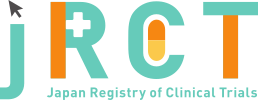臨床研究等提出・公開システム
|
May. 07, 2024 |
|
|
May. 23, 2025 |
|
|
jRCT2031240062 |
[M23-721] A Randomized, Phase 2/3 Study to Evaluate the Optimal Dose, Safety, and Efficacy of Livmoniplimab in Combination with Budigalimab Plus Chemotherapy Versus Pembrolizumab Plus Chemotherapy in Untreated Metastatic Non-Squamous Non-Small Cell Lung Cancer (NSCLC) |
|
[M23-721] Study to Evaluate Adverse Events, Optimal Dose, and Change in Disease Activity, with Livmoniplimab in Combination with Budigalimab Plus Chemotherapy Versus IV Infused Pembrolizumab Plus Chemotherapy in Adult Participants with Untreated Metastatic Non-Squamous Non-Small Cell Lung Cancer (NSCLC) |
Chika Yamagishi |
||
AbbVie G.K. |
||
3-1-21 Shibaura, Minato-ku, Tokyo |
||
+81-120-587-874 |
||
AbbVie_JPN_info_clingov@abbvie.com |
||
Contact for Patients and HCP |
||
AbbVie G.K. |
||
3-1-21 Shibaura, Minato-ku, Tokyo |
||
+81-120-587-874 |
||
AbbVie_JPN_info_clingov@abbvie.com |
Recruiting |
April. 24, 2024 |
||
| May. 27, 2024 | ||
| 840 | ||
Interventional |
||
randomized controlled trial |
||
double blind |
||
placebo control |
||
parallel assignment |
||
treatment purpose |
||
- Diagnosis of histologically or cytologically confirmed metastatic nonsquamous non-small cell lung cancer (NSCLC) with no known epidermal growth factor receptor (EGFR), anaplastic lymphoma kinase (ALK) mutation, or other genomic aberration for which a locally approved targeted therapy is available. |
||
- Received prior systemic therapy for the treatment of metastatic NSCLC. |
||
| 18age old over | ||
| No limit | ||
Both |
||
Non-Small Cell Lung Cancer |
||
Stage 1 (Cohort 1): Livmoniplimab Dose A |
||
Stage 1: Best Overall Response (BOR) of Complete Response (CR)/Partial Response (PR) [ Time Frame: Up to 21 Months ] |
||
Stage 1: Progression Free Survival (PFS) [ Time Frame: Up to 21 Months ] |
||
| AbbVie G.K. |
| Saitama Cancer Center institutional review board | |
| 780 Komuro, Ina-machi,Kitaadachi-gun, Saitama | |
+81-48-722-1111 |
|
| Approval | |
Mar. 26, 2024 |
Yes |
|
AbbVie is committed to responsible data sharing regarding the clinical trials we sponsor. This includes access to anonymized, individual and trial-level data (analysis data sets), as well as other information (e.g., protocols and clinical study reports), as long as the trials are not part of an ongoing or planned regulatory submission. This includes requests for clinical trial data for unlicensed products and indications. Supporting Information: Study Protocol, Statistical Analysis Plan (SAP), Clinical Study Report (CSR), Analytic Code Time Frame: Data requests can be submitted at any time and the data will be accessible for 12 months, with possible extensions considered. Access Criteria: Access to this clinical trial data can be requested by any qualified researchers who engage in rigorous, independent scientific research, and will be provided following review and approval of a research proposal and Statistical Analysis Plan (SAP) and execution of a Data Sharing Agreement (DSA). For more information on the process, or to submit a request, visit the following link. URL: https://www.abbvieclinicaltrials.com/hcp/data-sharing/ |
| NCT06236438 | |
| ClinicalTrials.gov |
United States/Australia/Belgium/Chile/France/Israel/Netherlands/Puerto Rico/Spain/Taiwan/Turkey |
